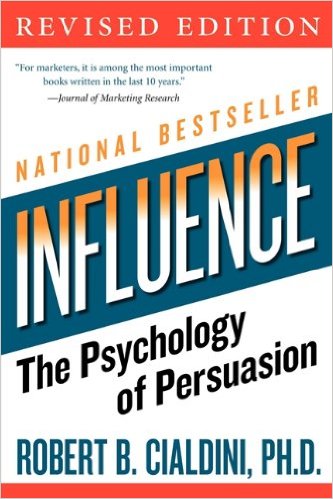I will admit it: I’ve been a bit prejudice. When I was recommended a book called Influence: The Science of Persuasion by Robert Cialdini, I thought to myself “wow, that is a very Machiavellian-sounding name.
However, as I read the introduction to the book, I was soon corrected. Cialdini is a professor at Arizona State University. His research on influence stems from his own confusion as to how he continues to end up with magazine subscriptions, kitchen appliances and charity direct debits that he never wanted.
He is an academic, trying to make sense of a world in which compliance professionals (sales people, charity chuggers, marketers) keep hoodwinking him. Of course, a true master of the Machiavellian art would disarm me by leading to believe this. But, if so, fair play: I’m sold.
He did his homework, applying for sales jobs and following people around to see how they worked. In the book, he describes many commonplace situations that many of us have probably found ourselves in. Everyone should read this book, if only to understand what has happened to us so many times over the years.
He breaks the tactics down into a series of topics. I will discuss some of the most interesting below.
Contrast principle
Sell someone a less expensive item after selling them something big. For example, why are extras on cars so expensive? The answer is that once you have spent £20,000 on a new car, £500 for a slightly-better-looking tyre seems like small change.
Reciprocity
When we are given a gift, we feel an obligation to give back. It is wired into us. This is a tactic used relentlessly by the Hari Krishna movement. They thrust a free gift into your hand, and then ask for a donation later.
I have a copy of the Bhagavad Gita on my shelf. And yes, I gave the guy a donation after he gave it to me.
It even works when you do not want the gift. At airports, Cialdini observed the Kristina’s in operation, scooping their gifts out of the bins people had thrown them in, to re-use on the next target.
I also fell for this in Milan. Around the major squares are groups of African men who put bracelets on tourists and then ask for money. Before I knew what was happening, there was a bracelet on my risk. And yes, I did give him a euro.
Cialdini points out that the defence strategy we most often use is to steer a wide mark around such people. Why? Because it is to hard to resist our natural urge to give back.
Concession
Concession is about asking for more than you want and then backing down. Say you want to borrow £50. Ask for £100. Then, when they say no, ask for just £50. Because you have made a confession, the other person will feel like they have to make a concession also. It also makes them feel like they have set the terms.
This can often be seen in extended warranties. “Do you want the 5-year super-protect plan? No? Okay, just the 3-year basic plan then?”
Declarations
Companies love to get you to declare that you like their product? Why? Because people are driven to act in a way consistent with what they have said.
Charities do this all of the time. They will give you a free sticker or ask you to sign up for free information. Why? Because once you have expressed that you are in some way a supporter of them, when they ask you for money, you are far more likely to feel you have to.
Written commitments are the best. These were used extensively by the Chinese communists during the Korean war. They would get American prisoners of war to write essay contests and give away small prizes. Once someone wrote something positive amount communism, they would have them read the essay out. Maybe even put it on the camp radio. Step by step, American soldiers were broken down as their guards asked for more and more.
Likability
Bad times for ugly people: being attractive helps. People are more likely to help out and be more generous to attractive people. Shared interests are important too. Salespeople love to find out your hobbies so that they can pretend they do them too.
Similarity is a big key here. You identify with people similar to yourself. So, if you want to market to a certain demographic, you need to use an actor from that demographic.
Finally, compliments are also powerful. Cialdini tells the story of a car salesman who earned more than almost anyone at the entire company. What was his secret? Every month he sent a postcard to all of his previous customers with three words on the front: “I like you”.
Summary
Compliance professionals are experts at getting us to do what they want. We do this because we work on auto-response. There is too much data in the world for us to sort through all decisions and check everyone’s back stories. So we use social cues to shortcut these decisions. Salespeople know we do this and try and exploit it.
Cialdini suggests the best defence is to listen to your gut. If you feel awkward, even if you cannot describe why it may be that you have been pressured into doing something you did not want to do. If so, follow Cialdini’s example and say “I’m not taking your product: no click wurr for me!”










